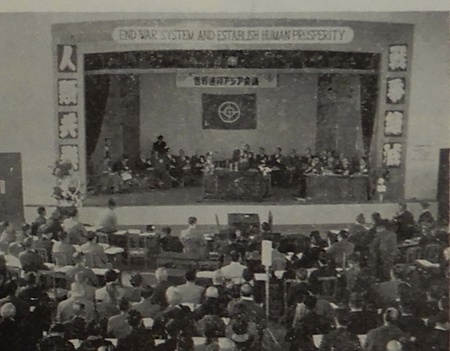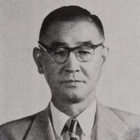At the request of the governor, he also became the prefectural public relations committee chairman.
After the outbreak of war between Japan and the United States, Kato Shinichi returned to his hometown of Hiroshima on a Japanese-American exchange ship and became a reporter for the Chugoku Shimbun newspaper, where he was once the deputy editor-in-chief. He was active in many areas, including serving as chairman of the employee union that was established within the company, but left the company in 1949 after serving there for seven years. According to Murakami Tetsuo, a senior colleague from his time at the newspaper company, he was asked by then Hiroshima governor Kusunoki Tsuneo to become the first chairman of the Hiroshima Prefecture Public Relations Committee, and continued to serve as chairman of the committee for over a year even after the governor was replaced by Ohara Hiroo in 1951.
In his biography in "A Centennial History of Japanese Americans in the United States," Kato wrote that he was appointed "Director of Public Relations for Hiroshima Prefecture" in 1949. It is not difficult to imagine that the governor of Hiroshima Prefecture, the site of an atomic bomb, would appoint a civilian like Kato, who has experience as a journalist, experience in the United States, and English language skills, to carry out public relations activities centered on peace issues.
So, I asked the Public Relations Division at the Hiroshima Prefectural Government what kind of activities they carried out. Unfortunately, however, Kato's name and the existence of the prefectural public relations committee chairman at that time were completely unknown. After asking them to look through past records, I finally found a record that said, "In 1950, Shinichi Kato was appointed chairman as a non-regular member of the Hiroshima Prefectural Public Relations Committee." I was also able to confirm that the committee was "an organization directly under the governor."
Since there are no records of anything else, we never knew. Considering Kato's subsequent contributions to the peace movement, this is sad.
Showa 25 corresponds to 1950, which is different from the 1949 mentioned by Kato and Murakami, but it is unclear which is correct.
Secretary General of the United Nations Association of Japan Hiroshima Prefecture Headquarters
Kusunoki, who had appointed Kato, ran as a candidate for the Liberal Party in the by-election for the Hiroshima Prefecture constituency in the House of Councillors in 1950, and was elected. According to Murakami, with the help of Kusunoki, who had become a member of the House of Councillors, Kato "transferred his registration to the United Nations, but for personal reasons resigned in March 1953 and travelled to the United States at the end of April."
Regarding his resignation as Hiroshima Prefectural Public Relations Committee Chair, the Yomiuri Shimbun newspaper, in its profile at the time of his death, stated that "I joined the prefectural government for a time, but it didn't suit me, so I went back to the US." As in the past, this shows Kato's way of life, in which he would leave a position without clinging to an organization if he was not satisfied with it or could not do the job he wanted to do.
When Murakami says he "transferred his registration to the United Nations," he is likely referring to his position as Secretary General of the Hiroshima Prefectural Headquarters of the United Nations Association of Japan, as he states in his profile.
The United Nations Association of Japan is a Public Interest Incorporated Foundation (UNA). What kind of organization is it? "It was established in 1947 with the aim of increasing understanding of and cooperation with the United Nations among the public from a private sector standpoint, and contributing to world peace and the improvement of the welfare of mankind. It has voluntary branch organizations all over the country, and internationally, as a leading member of the World Federation of United Nations Associations (WFUNA), a Class A consultative private organization to the UN, it is actively engaged in promoting the UN both domestically and internationally" (according to the association's website).
The world will have one government
From this point on, Kato became substantially involved in the peace movement and began working hard to promote the "World Federalist Movement." Having experienced war and the atomic bomb and knowing both American and Japanese society, Kato's idea of the World Federalist Movement was the World Federalist Movement. The World Federalist Movement, which is important for understanding Kato, can be summarized as follows, based on the website of the World Federalist Movement of Japan:
First, "The World Federation is a single democratic government (World Federal Government) in which the countries of the world will deal with global issues while maintaining their independence from each other."
"In 1946, enthusiastic world federalists from various countries gathered in Luxembourg and organized the World Movement for World Government (WMWFG), the precursor to the World Federalist Movement (WFM). The first conference was held in Montreux, Switzerland the following year in 1947. Representatives of 51 organizations from 23 countries gathered and announced the Montreux Declaration, which consisted of six principles, including: 1. All nations and peoples of the world should become members. 2. Regarding common global issues, each nation should transfer part of its sovereignty to a world federal government."
"The World Federalist Movement has developed rapidly with the support of scientists and politicians from around the world. In 1947, the World Federalist Movement (WFM) was formed as an international organization of world federalist movement groups from around the world, with its headquarters in New York. Currently, the WFM is made up of member organizations from 24 countries and regions."
"WFM provides input and advice to the United Nations as a Category II Consultative NGO under the UN Economic and Social Council."
In Japan, after the war, a bipartisan World Federation Japan Diet Committee was formed. "A movement began within the Diet to 'stand up beyond party lines to realize a world without war,' and on December 20, 1949, the World Federation Japan Diet Committee was formed by 104 bipartisan members of both houses of the Diet, with Komakichi Matsuoka, Speaker of the House of Representatives, as chairman and Kotaro Tanaka, member of the House of Councillors, and others as vice-chairmen."
World Federation of Asian Countries Appoints Secretary General
In November 1952, the World Federalist Asian Conference was to be held in Hiroshima. The World Federalist Group of British Parliamentarians proposed holding a World Federalist Conference in Hiroshima, the site of the atomic bombing in 1950, to raise a cry of peace to the whole world. This idea gained sympathy from promoters of the world federalist movement in Japan, and it was decided that the World Federalist Asian Conference would be held in Hiroshima, jointly sponsored by the World Federalist Construction Alliance, the World Federalist Japanese Diet Committee, and the World Federalist Hiroshima Council.

At that time, Kato was to serve as the Secretary General of the conference. It seemed that this would be the start of Kato's dedication to the peace movement, based in Hiroshima. However, as Murakami writes, "Due to personal reasons, he resigned as Secretary General of the Hiroshima Prefectural Headquarters of the United Nations Association of Japan in March 1953 (Showa 28) and left for the United States at the end of April.
It is unclear what the "personal reasons" were. Kato once again moved his base of operations to the United States.
(Titles omitted)
© 2021 Ryusuke Kawai






